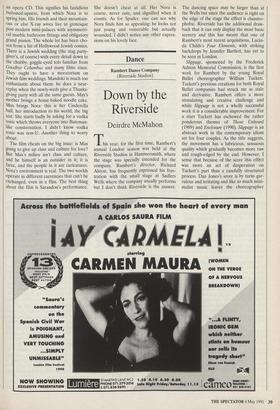Dance
Down by the Riverside
Deirdre McMahon
This year, for the first time, Rambert's annual London season was held at the Riverside Studios in Hammersmith, where the stage was specially extended for the company. Rambert's director, Richard Alston, has frequently expressed his frus- tration with the small stage at Sadlers Wells where the company usually performs but I don't think Riverside is the answer. The dancing space may be larger than at the Wells but since the audience is right on the edge of the stage the effect is claustro- phobic. Riverside has the additional draw- back that it can only display the most basic scenery and this has meant that one of Rambert's most recent acquisitions, Lucin- da Childs's Four Elements, with striking backdrops by Jennifer Bartlett, has yet to be seen in London.
Slippage, sponsored by the Frederick Ashton Memorial Commission, is the first work for Rambert by the young Royal Ballet choreographer William Tuckett. Tuckett's previous creations for both Royal Ballet companies had struck me as stale and derivative. Rambert offers a more stimulating and creative challenge and while Slippage is not a wholly successful work it is a considerable improvement. For a start Tuckett has eschewed the rather ponderous themes of Those Unheard (1989) and Enclosure (1990). Slippage is an abstract work in the contemporary idiom set for four couples. As the title suggests, the movement has a lubricious, sensuous quality which gradually becomes more raw and rough-edged by the end. However, I sense that because of the score this effect was more an act of desperation on Tuckett's part than a carefully structured process. Dan Jones's score is by turns gar- rulous and irritating and like so much mini- malist music leaves the choreographer stranded in mid-stream.
The same point might be made about Richard Alston's latest work, Roughcut, which is set to Steve Reich's New York Counterpoint and Electric Counterpoint. It is a big company display piece and Alston has created some wonderfully exhilarating movements for his 12 dancers, particularly in the final section when the dancers tra- verse the stage in pulsating waves. When I saw it a second time, however, I was more impressed by the quietly elegant duets and solos in the first half of the work.
After these minimalist scores, Soda Lake, which is performed in silence, came as a welcome relief. It is a seminal work in con- temporary British choreography which Alston created in 1981 at the beginning of his association with Rambert. Its austere simplicity is timeless: a dancer moves calm- ly and unhurriedly in space beneath Nigel Hall's elemental sculpture (inspired by a dry lake in the Mojave desert). Soda Lake was made for Michael Clark and has since been performed by Mark Baldwin. But in 1988 Alston experimented and gave the solo to one of the Rambert women, Cathrine Price. The shape and dynamic of her dancing were quite different, more silky and dramatic, but the piece still worked. This season Amanda Britton has taken over the role. Britton is a dancer with a clear, strong, no-frills style which makes the spacious phrases of the choreog- raphy instantly legible.
It was interesting to see another 1981 work revived: Plain Song, by Siobhan Davies, who is now Rambert's associate choreographer. Plain Song is set to early piano pieces by Satie, a composer whose limpidness has attracted choreographers such as Ashton, Cunningham and Alston. It has a lyrical, pastoral quality which I associate with a lot of Davies's work at the time. Sara Matthews gives a lovely perfor- mance in the first solo, which is full of rich- ly articulated movement.
Elsewhere in the repertory the standard of performance was more variable. Doubles seemed less fluent and technically assured and was the work which suffered most in the new ambience at Riverside. What was also disconcerting about Doubles was the rather unkempt appearance of the men. The designer stubble look may be all the rage but it is distinctly out of place in Mark Lancaster's pristine setting. It was like watching a group of Mickey Rourke clones.



















































 Previous page
Previous page